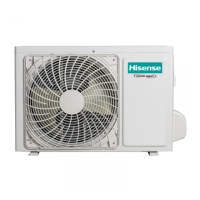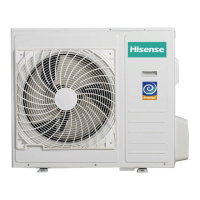
Do you have a question about the Hisense AMW2-16U4SGD1 and is the answer not in the manual?
| Power Supply | 220-240V, 50Hz |
|---|---|
| Energy Efficiency Ratio (EER) | 3.21 |
| Refrigerant | R410A |
| Type | Split Air Conditioner |
| Cooling Capacity | 16000 BTU/h |
| Features | Auto Restart, Turbo Mode, Sleep Mode, Timer |
Lists detailed specifications for indoor and outdoor units, including capacity, electrical data, and dimensions.
Provides specific technical details for key components like indoor fan motors and outdoor fan motors.
Details specifications for other components such as inductors and filters.
Shows dimensional drawings and key measurements for various indoor unit models.
Displays dimensional drawings and measurements for different outdoor unit models.
Shows the refrigerant flow for specific outdoor unit models.
Details the step-by-step process for evacuating the refrigerant system to ensure proper operation.
Outlines maximum refrigerant pipe lengths and height differences for optimal system performance.
Provides circuit diagrams for indoor and outdoor units, showing electrical connections for different models.
Explains the function and layout of indoor and outdoor unit control boards.
Lists parameters for outdoor compressor discharge temperature and other sensors.
Details general parameters and functions of the indoor unit's control system.
Explains operational modes and protection features for the outdoor unit.
Lists and explains fault codes displayed by the system, indicating potential issues.
Details how to check the refrigerant system's pressure and flow during cooling and heating operations.
Provides methods for testing specific parts such as indoor and outdoor fan motors.
Details the required clearances and mounting procedures for the indoor unit.
Instructions and visual guide for using the installation template for precise mounting.
Explains the drilling process for wall penetration, including the recommended angle for drainage.
Provides instructions on how to properly bend evaporator pipes to avoid damage during installation.
Covers placement, mounting, and installation considerations for the outdoor unit.
Specifies the required clearance distances around the outdoor unit for proper airflow and maintenance.
Details the mounting process for the outdoor unit base, including the use of bolts and shock pads.
Defines the maximum allowable height difference and connection pipe lengths for optimal system performance.












